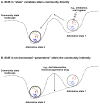The application of ecological theory toward an understanding of the human microbiome
- PMID: 22674335
- PMCID: PMC4208626
- DOI: 10.1126/science.1224203
The application of ecological theory toward an understanding of the human microbiome
Abstract
The human-microbial ecosystem plays a variety of important roles in human health and disease. Each person can be viewed as an island-like "patch" of habitat occupied by microbial assemblages formed by the fundamental processes of community ecology: dispersal, local diversification, environmental selection, and ecological drift. Community assembly theory, and metacommunity theory in particular, provides a framework for understanding the ecological dynamics of the human microbiome, such as compositional variability within and between hosts. We explore three core scenarios of human microbiome assembly: development in infants, representing assembly in previously unoccupied habitats; recovery from antibiotics, representing assembly after disturbance; and invasion by pathogens, representing assembly in the context of invasive species. Judicious application of ecological theory may lead to improved strategies for restoring and maintaining the microbiota and the crucial health-associated ecosystem services that it provides.
Conflict of interest statement
There are no conflicts of interest.
Figures


References
Publication types
MeSH terms
Substances
Grants and funding
LinkOut - more resources
Full Text Sources
Other Literature Sources
Medical

